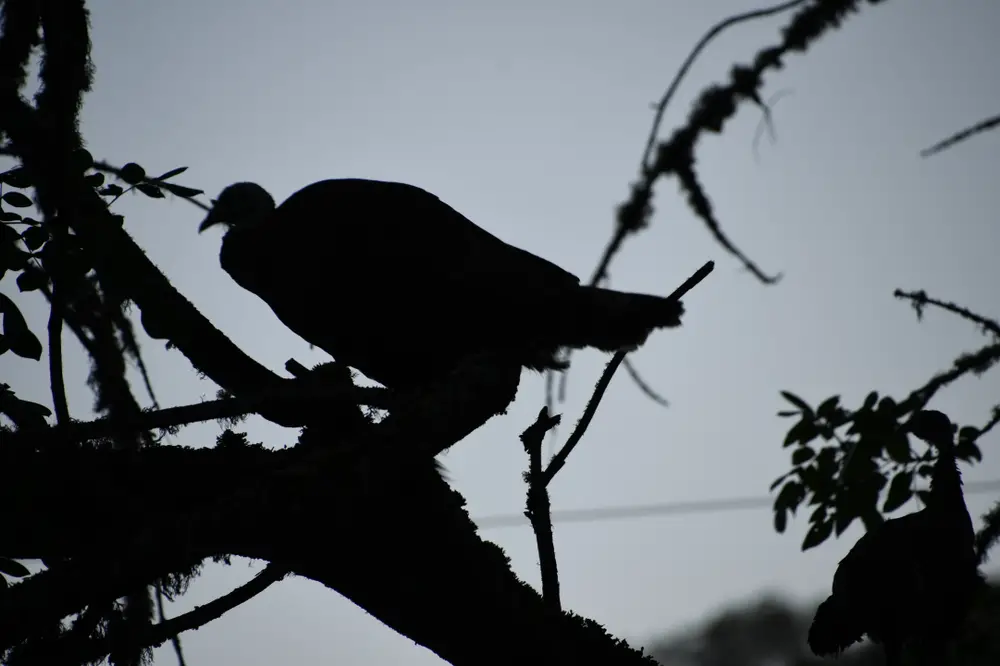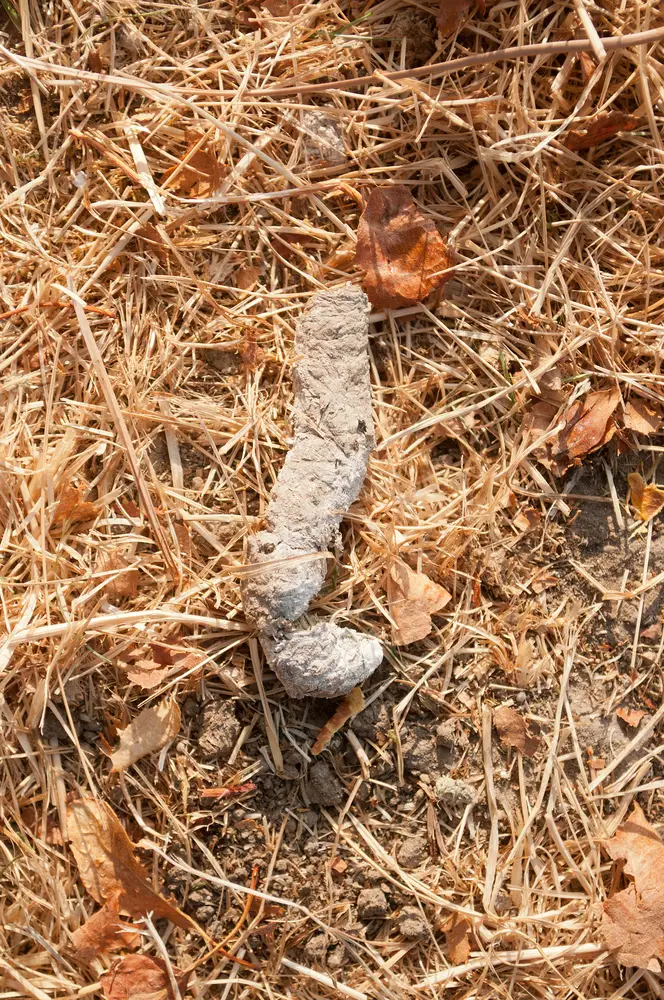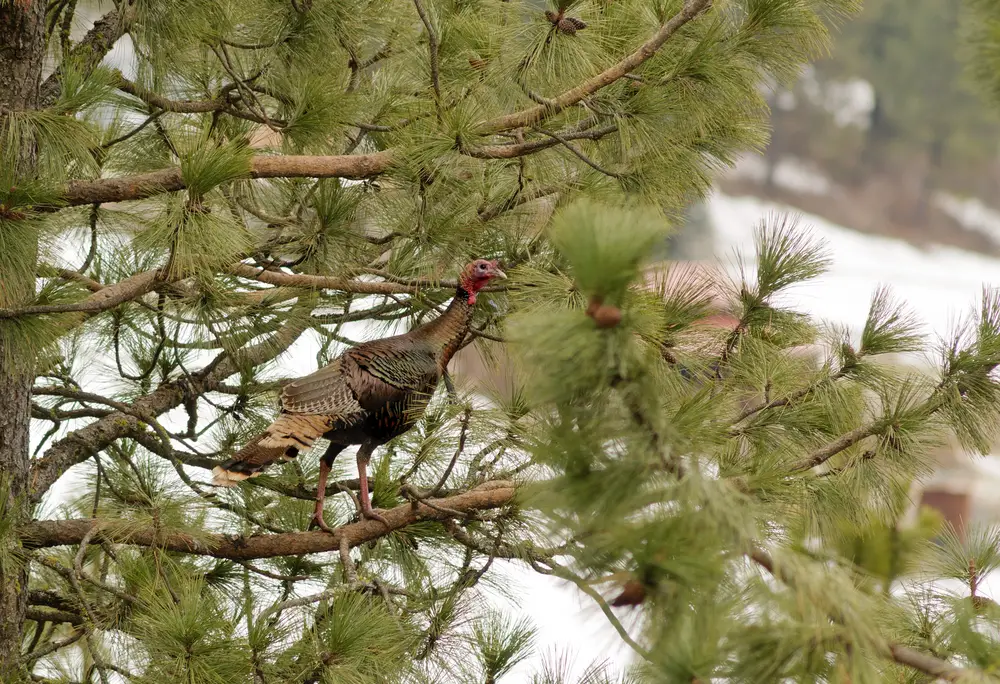When you find a turkey roost, you’ll have a successful turkey hunt. That’s good news! Even better news, turkey roosts are one of the easiest things to find in the wild. Here are a few simple tips that you can use to scout for one as early as during your preseason scouting or as late as the day of your hunt.

A turkey roost is a large, sturdy tree with plenty of thick branches growing at right angles that provide turkeys with a high, safe place to spend the night. The best roosting branches will originate from the trunk, be roughly 25 feet above the ground, and offer a comfortable perch to sit and sleep.
Scouting for turkey roosts.
Scouting for turkey roosts is all about looking for the perfect tree. Here are the characteristics a turkey is looking for a good roosting tree.
- Protection. Turkey roosts are found in trees that offer protection from the wind and elements. Depending on the size of the flock, more than one tree may be needed. In the fall, they prefer trees like the evergreen and those conifer trees that do not shed their needles. In warmer areas, turkeys roost in maple, oak, and other thickly canopied trees.
- Easy access and egress. Depending on the size of the flock, more than one tree may be needed. And, because turkeys have limited flight abilities, turkey roosts usually feature wide open and clean forest floors to take off from and land in the tree.
- A nearby food source. Many turkey roosts are located within landing distance of a field or clearing. If these fields have enough insects, berries, grasses, or other foods, the flock will quickly land there at sunrise and forage together.
If both food and water are available, turkeys may return to the same roost for several nights in a row. However, if the habitat is plentiful and enough trees are available, turkeys will have several roosting places nearby.

Using sign to find a turkey roost.
When you have found a potential turkey roost, it’s time to see if it is currently or recently used as a roost. Begin by looking for turkey tracks, feathers, scraped earth, and turkey poop. A jake or tom leaves poop with a ”J” shape; a hen leaves a spiral shape.
Since turkey feces contains both feces and urine (like a chicken’s droppings), moist turkey poop tells you this roost was used very recently.
Find a turkey roost with your eyes and ears.
While scouting for a turkey roost early in the morning or just before sunset, watch and listen for the turkeys themselves.
If you catch sight of a grounded flock shortly after sunrise, they just came down from a roost somewhere close. If you spot a flock of turkeys 30 minutes before sunset, stay out of sight and watch where they fly up and which tree they use.
A flock of turkeys can also make enough noise for you to locate and confirm their current roosting place.
Turkeys are very talkative birds at the first hint of sunrise. They gobble the moment they start to stir and will continue to do so, right up to the moment they fly down.
During the morning fly down, turkeys make a loud, distinct sound. Upon landing, the turkeys start communicating their location. Just before sunset, you will also get a chance to hear the noise the turkeys make trying to fly the 25 or so feet up their night perches.

Using calls to locate a turkey roost.
After sunset or just before daylight, you can often use a call to confirm a turkey roost is currently in use. All you have to do is get a tom to gobble for you!
This part is easy. Using a crow or owl caller make a few loud calls. If their is a roosted tom nearby, he will let out what is called a shock gobble.
This is also a helpful way to blind call for turkey roosts. In areas where you suspect roosts might be, make a few loud crow calls and wait to see if you get a response. If you do, silently stalk forward and cut the distance to the source of the gobble. Repeat as necessary until you can identify the actual turkey roost in use.
What to do after you find a turkey roost.
The first piece of advice after you find a turkey roost is don’t get busted. Stay far enough away from the roost to avoid being spotted. If you ignore this tip, one of two things will happen. One, the turkeys may abandon the roost and relocate to another area. Two, the turkeys may fly down in a direction opposite to you and immediately run off.
Next, you have to decide how you will use your new found knowledge to hunt for a tom. Will you move in under the cover of darkness and set up a blind or decoy?
Will you set up close to the roost and immediately engage a tom as it flies down? Or will you use this location as a base of further knowledge about turkey movements and patterns and hunt between the spaces they inhabit during the day?
These are all personal and valid choices. Whether you blind call while seated against a tree or spend the time and effort to locate a turkey roost and then hunt right up against it, it’s all still turkey hunting.

